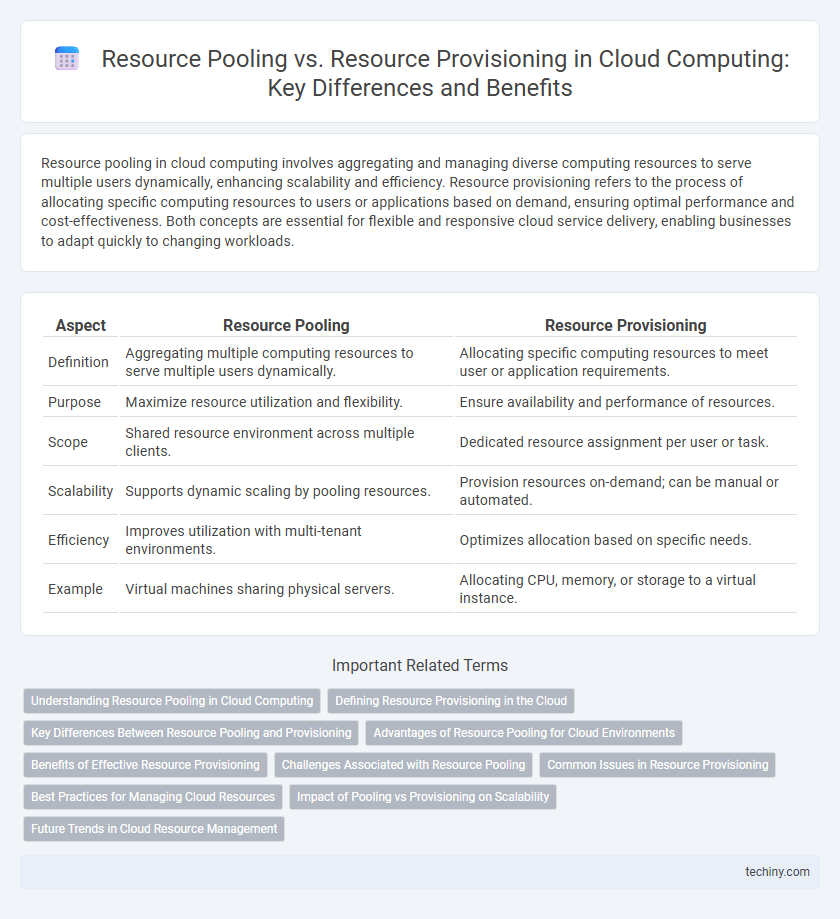Resource pooling in cloud computing involves aggregating and managing diverse computing resources to serve multiple users dynamically, enhancing scalability and efficiency. Resource provisioning refers to the process of allocating specific computing resources to users or applications based on demand, ensuring optimal performance and cost-effectiveness. Both concepts are essential for flexible and responsive cloud service delivery, enabling businesses to adapt quickly to changing workloads.
Table of Comparison
| Aspect | Resource Pooling | Resource Provisioning |
|---|---|---|
| Definition | Aggregating multiple computing resources to serve multiple users dynamically. | Allocating specific computing resources to meet user or application requirements. |
| Purpose | Maximize resource utilization and flexibility. | Ensure availability and performance of resources. |
| Scope | Shared resource environment across multiple clients. | Dedicated resource assignment per user or task. |
| Scalability | Supports dynamic scaling by pooling resources. | Provision resources on-demand; can be manual or automated. |
| Efficiency | Improves utilization with multi-tenant environments. | Optimizes allocation based on specific needs. |
| Example | Virtual machines sharing physical servers. | Allocating CPU, memory, or storage to a virtual instance. |
Understanding Resource Pooling in Cloud Computing
Resource pooling in cloud computing refers to the provider's ability to serve multiple consumers using a multi-tenant model by dynamically assigning and reassigning physical and virtual resources according to consumer demand. It optimizes hardware utilization by abstracting resources such as storage, processing, memory, and network bandwidth into a collective pool accessible on-demand. This abstraction allows for scalable, flexible, and efficient resource management, reducing operational costs and improving service availability.
Defining Resource Provisioning in the Cloud
Resource provisioning in cloud computing involves the dynamic allocation and management of virtualized resources such as CPU, memory, storage, and network bandwidth to meet fluctuating workload demands. It ensures optimal utilization of cloud infrastructure by automating the deployment and scaling of resources based on predefined policies and real-time performance metrics. Effective resource provisioning minimizes costs and enhances application performance by aligning resource availability with user requirements in multi-tenant cloud environments.
Key Differences Between Resource Pooling and Provisioning
Resource pooling in cloud computing aggregates and shares physical and virtual resources across multiple users, enabling efficient utilization and scalability. Resource provisioning involves the allocation and configuration of these pooled resources to meet specific application or user demands. The key differences lie in pooling's focus on resource aggregation for multi-tenancy, while provisioning centers on delivering tailored resources for individual workloads.
Advantages of Resource Pooling for Cloud Environments
Resource pooling in cloud computing allows multiple clients to share a consolidated set of computing resources, such as storage, processing power, and network bandwidth, which significantly improves resource utilization and reduces operational costs. This approach enhances scalability by dynamically allocating resources based on demand, ensuring optimal performance and flexibility for various workloads. By enabling multi-tenancy, resource pooling also strengthens security isolation and simplifies maintenance through centralized management and monitoring.
Benefits of Effective Resource Provisioning
Effective resource provisioning in cloud computing ensures optimal allocation of computational resources, enhancing system performance and reducing operational costs. It enables dynamic scaling to meet fluctuating workloads without over-provisioning, thus maximizing resource utilization and minimizing waste. Precise provisioning supports improved application reliability and user experience by maintaining consistent service levels.
Challenges Associated with Resource Pooling
Resource pooling in cloud computing enables multiple users to share a common set of resources, but it faces challenges such as maintaining data security, ensuring resource isolation, and handling dynamic workloads efficiently. The risk of resource contention and performance degradation increases as multiple tenants access shared resources simultaneously. Effective monitoring, robust virtualization techniques, and sophisticated resource management algorithms are essential to mitigate these challenges and optimize performance.
Common Issues in Resource Provisioning
Resource provisioning in cloud computing often faces common issues such as resource contention, over-provisioning, and latency in allocating virtual machines or storage. Inefficient resource allocation can lead to increased operational costs and degraded application performance. Effective monitoring and automation tools are essential to mitigate these challenges and ensure optimal utilization of pooled resources.
Best Practices for Managing Cloud Resources
Effective management of cloud resources requires a strategic balance between resource pooling and resource provisioning to optimize utilization and reduce costs. Implementing automated orchestration tools enables dynamic resource pooling across multiple tenants, improving scalability and fault tolerance. Best practices include continuous monitoring and predictive analytics to adjust provisioning in real-time, ensuring resources are allocated efficiently without over-provisioning or underutilization.
Impact of Pooling vs Provisioning on Scalability
Resource pooling in cloud computing aggregates diverse resources into a unified pool, enabling dynamic allocation based on demand, which significantly enhances scalability by allowing seamless resource sharing and load balancing. Resource provisioning, involving the allocation and configuration of resources for specific applications, directly impacts scalability through the responsiveness and flexibility of scaling up or down resources as needed. Effective pooling maximizes resource utilization and reduces latency in scaling processes, while optimized provisioning ensures precise resource matching, both critical for achieving high-performance scalability in cloud environments.
Future Trends in Cloud Resource Management
Future trends in cloud resource management emphasize dynamic resource pooling combined with AI-driven automation to optimize scalability and efficiency. Advanced predictive analytics enable proactive resource provisioning tailored to fluctuating workloads, enhancing performance while reducing operational costs. Integration of edge computing resources into centralized pools further extends resource availability and responsiveness across distributed cloud environments.
Resource Pooling vs Resource Provisioning Infographic

 techiny.com
techiny.com